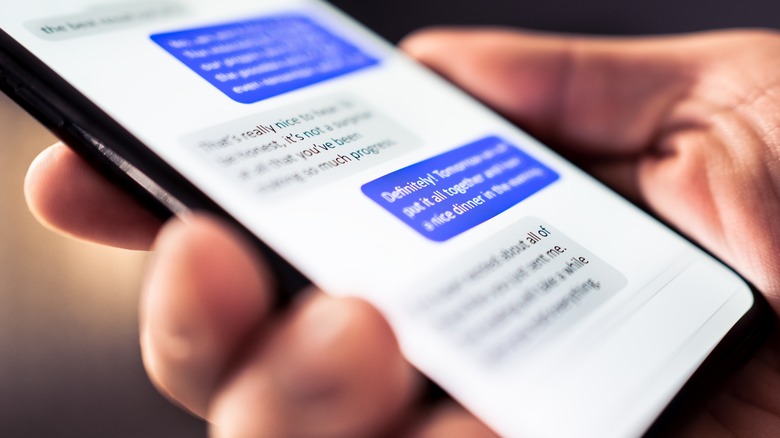Why Your Android Says Attachment Limit Reached (And How To Fix It)
Few things are as frustrating as finding the perfect reaction gif only to get hit with the "attachment limit reached" error warning that your message won't get delivered. This message appears when a picture, video, or any other file attached to a message is too large to be sent over text. Even more frustrating is that an attachment's maximum file size varies from carrier to carrier, so it can be hard to keep track of what you can and can't send. Thankfully, however, there are ways to get around this restriction.
Each of these workarounds has its pros and cons — namely, whichever one you choose, you must get the recipient to agree to use the same method. That means either convincing them to enable RCS (assuming their device supports it) or to download a third-party messaging app that uses Wi-Fi. If the recipient isn't willing to make these changes, the only other option is to compress the file you want to attach, which — while effective — is less than ideal, as doing so degrades its quality.
Enable RCS messaging
A simple way to get around the file size restriction on Android is to enable Rich Communication Services (RCS). This form of Android messaging is the answer to the iPhone's iMessage app. Instead of sending messages via SMS/MMS, RCS bypasses the device's mobile provider by sending messages via Wi-Fi. However, older Android phones and devices with mobile carriers that don't support RCS cannot use the feature. There are a limited number of texting apps that support RCS at the time of writing.
How to enable RCS in Google Messages:
- Open the Google Messages app or download it from the Google Play Store if you do not have it.
- Tap the user icon in the top right corner.
- Select Messages Settings in the drop-down menu.
- Tap the RCS Chats option, which is listed as Chat Features on some phones.
- Toggle on the RCS Chats setting.
If you have a Galaxy smartphone, you can use RCS messaging in Samsung Messages instead, but it isn't as straightforward. The carrier must support the app's advanced messaging feature, which is what Samsung calls RCS. To check whether it's enabled:
- Open the Samsung Messages app.
- Tap the three vertical dots.
- Tap Settings.
- Look for Chat Settings — if it is grayed out, that means your carrier doesn't support the Samsung app's RCS feature. If the feature isn't grayed out, that means you can use RCS in Samsung Messages.
Activating RCS will allow you to send files up to 100 MB. However, for RCS to function, both you and the person you are messaging must have the feature enabled, and you may need to disable your phone's built-in power-saving feature for it to work.
Compress the file
If you or the person you are messaging cannot access RCS, you can try to compress the file and send it over the old fashion way via MMS. How much you'll need to compress the file depends on your wireless service carrier. For example, the file limit with Verizon is 1.2 MB for images and 3.5 MB for videos.
One of the easiest ways to compress media files is through the web browser. Sites such as YouCompress and Compress2Go will automatically compress your uploaded images, videos, and other files. You can tinker with the sites' settings to produce a file at or below your carrier's limit. But keep in mind that the more a file is compressed, the lower its quality becomes. This can make images and videos come out blurry or pixelated.
Alternatively, if you're trying to send a video or image that is too large, you can use an editing app to reduce its resolution. Most Android phones ship with a built-in image and video editor, but the exact steps to change the resolution will vary depending on which app you use.
Use a third-party messaging app
Another way to send large files over messaging is through a third-party messaging app. Telegram and WhatsApp are two popular third-party messaging apps worth checking out. What differentiates messaging on these apps from SMS and MMS is that they send messages via Wi-Fi and mobile data in the same way as RCS.
This allows users to bypass their mobile service provider's restrictions. Some of these apps even offer higher attachment file size caps than RCS. For example, Telegram has a file size limit of 2 GB. These apps also add RCS and iMessage comparable features such as emojis and read receipts.
This technique's biggest and most obvious downside is that it requires both parties to install the same app, and not everyone wants to juggle a second or even third messaging app on their phone. Still, it is currently the only way to put Android and iPhones on the same playing field regarding attachment size limit and messaging.



